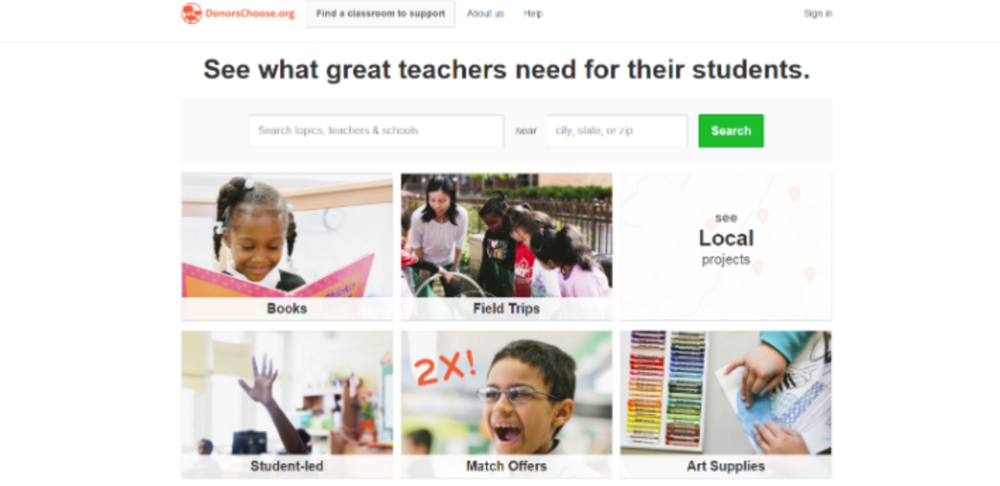Fifteen years ago, public school teacher Charles Best started DonorsChoose.org out of his classroom in the Bronx. He set out with a simple idea: Invite teachers to request supplies they need and allow citizen donors to make direct connections with specific classrooms.
The mission of DonorsChoose.org isn’t unique. On the contrary, there are many organizations that support public school teachers and students. It’s the technology platform behind the mission that allows DonorsChoose.org to grow and scale quickly for a nonprofit.
When we think about branding and awareness, we think like many other nonprofit organizations do. We have to be totally transparent with how we conduct our business to gain donors’ trust, and how we serve our beneficiaries, what it costs us to do that, and how efficiently we do it is deeply linked to our brand. We also have to tell our story in an emotional way that tugs on people’s heartstrings and feels deeply personal.
But when it comes to the rest of the marketing funnel—acquisition, conversion, and retention—we think more like a retailer than a traditional nonprofit. Our team’s goal is “dollars to kids.” This means getting customers (or “citizen donors”) to go to our website, find classroom projects that speak to them, put the projects in their shopping cart, and go through the checkout flow.
Our technology platform has allowed us to take marketing principles from retail and apply them to nonprofit marketing. And just like in retail, personalization is key. For us, personalization increases donor loyalty and boosts conversion.
So, how do we create a personalized philanthropic experience from beginning to end? Here’s what we’ve learned.
1. Let them choose. Allow donors to choose exactly where their money goes, and let them express their passions when they do it. We give donors search criteria, similar to a retailer, where they can customize the projects based on school subject, grade level, or the dollar amount needed to fulfill the project. So, if a donor loved reading Dr. Seuss as a child and he only has $25 to give, he can find hundreds of projects to choose from.
2. Create a feedback loop. When a donor gives to a classroom, our platform facilitates a direct connection to those teachers and students. We invite the donor to leave a message for the classroom, and the teacher sends a thank you note to the donor, usually within 24 hours of their donation. When we ship the supplies to the classroom, we send a notification to the donor, which was inspired by e-commerce emails that we received. Then the teacher uploads an “impact letter” and photos of students using the resources. While we never ask for more donations during the feedback loop, many donors get inspired to give again.
3. Use data to personalize your emails. Email is the number one tactic for driving repeat giving from citizen donors. Of the $45 million we will raise from individual donors this school year, nearly $20 million will come from donors responding to emails we send. Email is so important because it allows us to tell a heartwarming story of a classroom that we know the donor will care about. If a donor lives in Chicago and loves gardening, we will send them a classroom project for a school garden down the street from her home. In fact, personalized emails are three-times more likely to convert a donor than non-personalized emails.
Our donors are adopting our retail mentality, too, which provides both opportunities and challenges. For instance, this fall we sent an email campaign asking teachers to support basic school supplies during the back-to-school season. We didn’t use tight enough geographic targeting, and we received multiple responses from donors who were disappointed with the selection. One donor said, “You know where I live—why did you send a project so far away?”
Because our donors are coming to us with high targeting expectations, we suspect this will become more and more common for philanthropic giving. We intend to launch a customized homepage for return visitors, add more personalization fields to our emails, and digitize student thank-you notes for donors, to meet this growing demand.
About the author:
Katie Bisbee leads the marketing and branding for DonorsChoose.org as the organization’s CMO, engaging more than 2 million donors and teachers in public school classroom support. Before forming the marketing team, Katie led the expansion to serve schools across the east coast. Prior to DonorsChoose.org, Katie launched a customer acquisition business at Red Ventures, a company ranked on the Inc. 500 list as one of the nation’s top 20 fastest growing companies. She’s also conducted market research for commercial, nonprofit, and political clients. Katie earned her M.B.A. from the Darden School at the University of Virginia, where the faculty awarded her the Hyde Fellowship for her contributions to the school. She is an alumni of Leadership Charlotte (2011) and was named to Charlotte Business Journal’s “40 Under 40” (2010).








